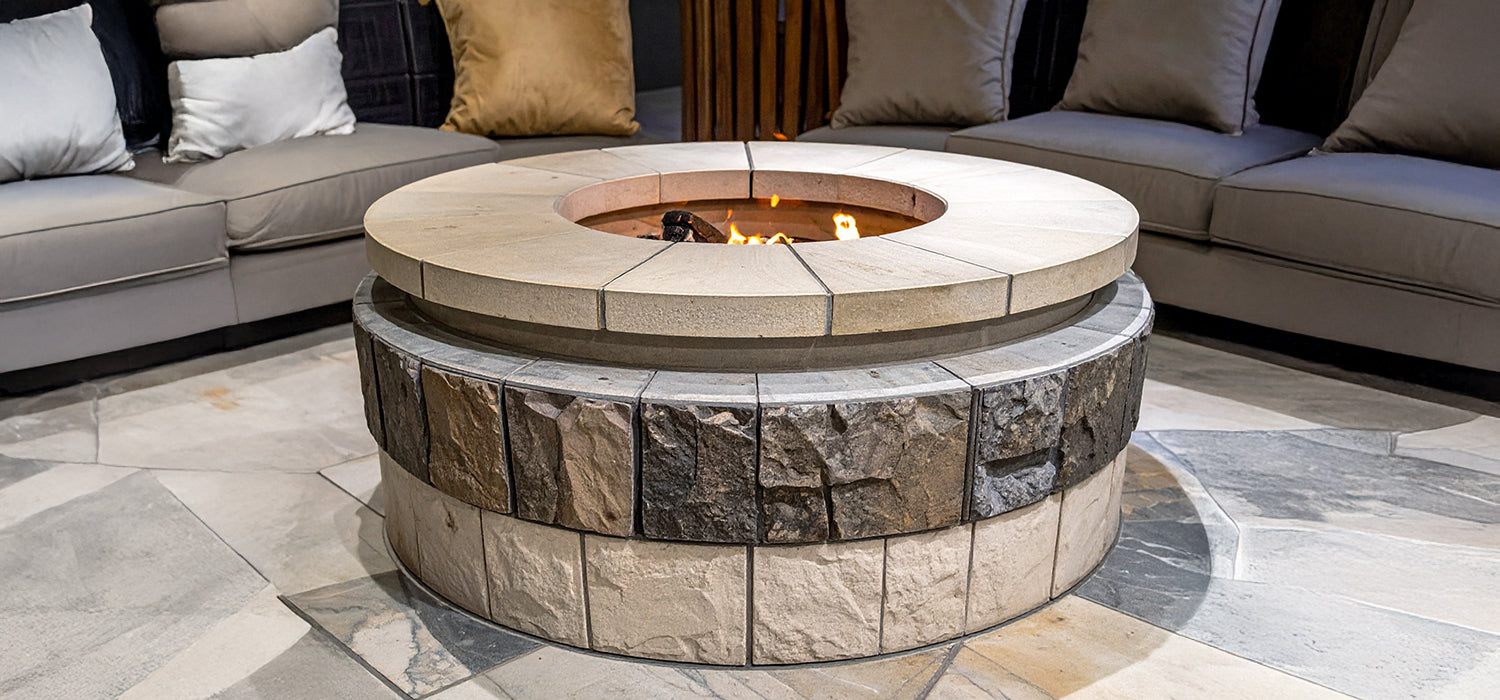
How to Fix a Fire Table That Won’t Stay Lit
Nothing ruins a cosy backyard gathering faster than a fire table that won’t stay lit! The good news? It’s usually an easy fix. From gas issues to simple cleaning, we’ll walk you through the common culprits. Keep reading to keep your fire tables glowing all night long!
Common Causes of Flame Extinguishing
There’s nothing quite like sitting around a fire table on a cool evening, but when that flame just won’t stay lit, the mood quickly shifts. Let’s take a look at the usual suspects that might be causing your flame to fizzle out.
Gas Supply Issues:
Gas problems are often the root of the issue when it comes to fire tables that won’t stay lit. If you're struggling to keep your flame going, it’s time to check the gas supply.
Low Propane Tank or Interrupted Natural Gas Supply
First things first, make sure you’ve got enough gas. A low propane tank is a prime culprit for flame problems. Check your tank’s fuel level — if it’s low, no amount of fiddling with settings will keep that flame alive. If you’ve got natural gas, take a look at your supply line for any interruptions or leaks.
Regulator Problems
The regulator is key to controlling the flow of gas, so if it’s faulty, you might see your flame flicker and die out. A clogged or broken regulator can mess with the gas flow, making it impossible for your fire table to maintain a steady flame. If you suspect the regulator’s the issue, a quick adjustment or replacement might just do the trick.
Wind and Weather Conditions:
Mother Nature’s elements can wreak havoc on your fire table, especially when wind and rain come into play. If your flame is flickering like it’s trying to signal a distress call, check your surroundings.
Strong Winds Blowing Out the Flame
We’ve all experienced a windy day where everything’s a bit more difficult than usual. Fire tables are no exception — strong winds can easily blow out your flame. If your table is in an open area, the wind could be your number one enemy. In such cases, repositioning your fire table in a sheltered spot could save the day.
Rain or Moisture Affecting the Burner
Rain might be lovely when you’re inside with a cuppa, but it’s not doing your fire table any favours. Moisture can cause rust and corrosion on the burner, messing with its performance. If the burner gets too wet, your flame may struggle to stay on, or worse, refuse to light at all.
Burner and Ignition System Problems:
Sometimes, the issue lies deeper within the burner system. If you’ve checked everything and still can’t get the fire to stay lit, the burner or ignition system might be to blame.
Clogged Burner Ports
Burner ports are the little openings where the gas flows to create the flame. If they’re clogged with dirt, spider webs, or other debris, the gas can’t flow properly, causing your flame to sputter or go out. Regular cleaning is essential for keeping things running smoothly.
Faulty Ignition System
The ignition system is responsible for lighting your fire, so if it’s on the blink, your flame may not get started at all. A faulty igniter or a problem with the wiring could be to blame. It’s worth checking whether your spark electrode is properly positioned or if the wiring needs attention.
Troubleshooting Steps
Before you panic and call in a professional, let’s run through some simple troubleshooting steps. These actions can help you identify and fix the problem in no time.
Checking Gas Supply:
Start by making sure your gas supply is in order. After all, no gas means no flame!
Refilling Propane Tank or Checking Natural Gas Line
If you’re using propane, check the tank to see if it’s running low. If it’s almost empty, top it up and try again. For those on natural gas, ensure the supply line is secure and there’s no interruption in the flow.
Inspecting and Adjusting the Regulator
The regulator should be checked regularly for wear and tear. If it’s blocked, damaged, or faulty, it won’t allow the proper amount of gas to reach the burner. If you spot any issues, adjusting or replacing the regulator could resolve the issue.
Protecting from Wind and Weather:
If the weather’s the cause of your flame issues, there are a few ways you can shield your fire table from the elements.
Using Wind Guards or Shields
Wind can easily put out your flame, but wind guards or shields can help to protect it. These accessories are designed to direct the wind away from the flame, ensuring a steady fire even when the weather's trying to put it out.
Covering the Fire Table When Not in Use
When you’re not using your fire table, covering it up can keep rain, moisture, and debris from causing damage. A waterproof cover is a small investment that can save you from much larger problems in the future.
Inspecting and Cleaning the Burner:
A bit of regular TLC for your burner system can go a long way. If it’s clogged or dirty, that’s often enough to cause problems.
Cleaning Clogged Ports with a Brush
If you’ve got clogged burner ports, use a soft brush to clean them out. A gentle brush will remove any debris without damaging the burner or igniter components.
Checking for Damage or Corrosion
Inspect your burner for any signs of wear or corrosion. If it looks worn out, corroded, or damaged in any way, that could be affecting its performance. A quick inspection could save you a costly repair down the line.
Repairing or Replacing Components
When it comes to repairs, sometimes you can fix things yourself, but other times, you’ll need to replace components entirely. If troubleshooting doesn’t do the trick, here's what to look at.
Ignition System Repair or Replacement:
The ignition system is crucial for lighting your fire table, so if it’s faulty, replacing it might be your best option.
Replacing Faulty Igniter or Wiring
If you’ve found that your igniter isn’t working properly, or the wiring is damaged, it’s time for a replacement. If you’re not comfortable doing it yourself, it’s worth calling in a professional to ensure it’s done safely and correctly.
Burner Replacement:
If your burner is too far gone, it may need to be replaced entirely.
Replacing Damaged or Corroded Burner
Over time, burners can become corroded, damaged, or clogged beyond repair. If your burner is beyond cleaning, replacing it with a new one will restore your fire table to its former glory.
Conclusion
Dealing with a fire table that won’t stay lit can be frustrating, but it’s usually not as bad as it seems. By identifying the common causes, following troubleshooting steps, and addressing any necessary repairs or replacements, you’ll have your fire table burning bright again in no time.
Remember, regular maintenance and some simple checks can save you from major issues down the line. Whether it’s adjusting the gas regulator, cleaning the burner, or shielding your table from the weather, taking care of your fire table ensures many more nights of warmth and light. So, don’t let a flickering flame ruin your evening — get your fire table fixed and enjoy those cosy gatherings once more!
Other content we think you'll love
- How to Light a Gas Fire Pit: The Complete Guide to Safe and Easy Lighting
- How to Fix a Gas Fire Pit: Troubleshooting and Repairs Made Easy
- How to Light a Gas Fire Pit with a Lighter: A Step-by-Step Guide
- Why Does My Gas Fire Pit Keep Going Out?
- How to Repair a Gas Fire Pit: A Step-by-Step Guide
- How to Repair Your Outdoor Gas Fire Pit: A Homeowner’s Guide to Fixing Common Problems
- Why Does My Gas Fire Pit Whistle? Troubleshooting and Fixes
- Why Does My Gas Fire Pit Sound Like Wind? Here’s What’s Going On
- How to Turn On Your Gas Fire Pit: A Step-by-Step Guide
- How to Safely Put Out Your Fire Pit (Without Stressing or Guessing)
- Why Is My Gas Fire Pit Not Lighting? Here’s How to Fix It Fast

